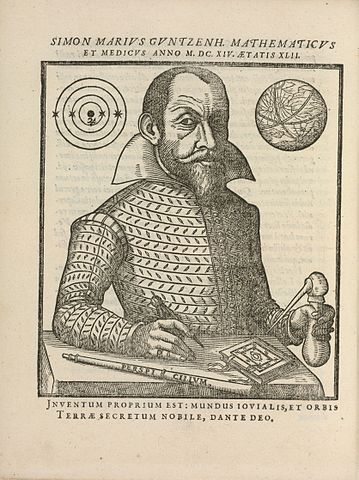
Image 1 Caption: "Engraved portrait of Simon Marius (1573--1625) from his book Mundus Iovialis (1614)." (Slightly edited.) Note Renaissance astronomers had a tendency to look like Faust who is immortalized in Doctor Faustus (play c.1592). Maybe it was a professional requirement to assure customers that they were really topnotch astrologers.
Simon Marius (1573--1625) independently (but NOT firstly) and telescopically (firstly) discovered Andromeda nebula (i.e., the Andromeda Galaxy (M31,NGC 224)) on 1612 Dec15 (Wikipedia: Simon Marius: Discoveries; Wikipedia: Andromeda Galaxy: Observation history; SEDS: Simon Marius (January 20, 1573 - December 26, 1624); No-402). His discovery was, of course, for a long time the effective discovery relative to Europe.
Note, Simon Marius could only see the Andromeda nebula as fuzzy cloud with his small primitive telescope. He probably could NOT see its fiducial modern size on the sky: ∼ 3° x 1° (see AstroPixels.com: M31 - Andromeda Galaxy). The spiral arms (i.e., spiral structure) of the Andromeda nebula was discovered by Lord Rosse (1800-1867) in 1850 using the largest reflector telescope of that time, Lord Rosse's own Leviathan of Parsonstown (1.83 m primary, operational 1845--c.1890) (see Wikipedia: Andromeda Galaxy: Observation history).
The early history of the observation of the Andromeda galaxy:
- As a
naked-eye astromomical object,
the Andromeda galaxy was observed
casually as a "cloudy star"
without comment
by myriads going back into indefinitely
into prehistory.
The "cloudy stars"
were eventually called
nebulae (used in the historical sense here).
"Nebula" is just Latin for
cloud
(see nebula (Latin)).
- Ptolemy (c.100--c.170 CE)
listed 6
or 7
nebulae in his
2nd century CE
catalog of 1022 stars in
48
constellations
(see No-113,402;
Wikipedia: Almagest: The star catalog).
Tycho Brahe (1546--1601)
listed 6 nebulae
in his catalog of stars
(see Wikipedia:
Tycho Brahe: Observational astronomy).
Surprisingly, both of these
astronomers
(Ancient
and Renaissance)
missed the Andromeda nebula
(No-402).
- Medieval Islamic astronomer
al-Sufi (903--986, in Europe AKA
Azophi Arabus)
in his
Book of the Fixed Stars (circa 964)
is the first to put the
Andromeda nebula
in the historical record
as a nebula (historical sense)
(see No-188,402;
Wikipedia: Andromeda Galaxy:
Observation history;
Wikipedia:
Book of the Fixed Stars: Influence).
Al-Sufi
seems to attribute the recognition
of the Andromeda nebula
as a nebula (historical sense)
to Medieval Islamic astronomers
in Isfahan
very probably before
905.
- Al-Sufi's
work was known in
Europe
by the
14th century
(see
Astronomical atlas by al Sufi,
Middle of the XIVth century, north of Italy;
Biography of al-Sufi;
Duerer's hemispheres of 1515 -
the first European printed star charts).
However, the references do NOT state if
Simon Marius or
other
Renaissance astronomers
were
aware that the
Andromeda nebula
had been recognized as a
nebula (historical sense)
before Simon Marius
in 1612.

- Image 2 Caption: A woodcut sky map of the nothern celestial sphere by Albrecht Duerer (1471--1528), circa 1515.
The constellation Andromeda (with an overlaid portrayal of the mythical Andromeda) is to the left of constellation Pegasus near the top of the sky map.
Decorative imaginative portraits of astronomers are shown in the corners clockwise from the upper left: Aratus (c.315--c.240 BCE), Ptolemy (c.100--c.170 CE), al-Sufi (903--986, in Europe AKA Azophi Arabus), Marcus Manilius (fl. 1st century CE).
- Image 2 Caption: A woodcut sky map of the nothern celestial sphere by Albrecht Duerer (1471--1528), circa 1515.
- Images:
- Credit/Permission:
Anonymous artist,
1614
(uploaded to Wikimedia Commons
by User:Rob_at_Houghton,
2014) /
Public domain.
Source: GC6 M4552 614m, Houghton Library, Harvard. Image link: Wikimedia Commons: https://commons.wikimedia.org/wiki/File:Houghton_GC6_M4552_614m_-_Simon_Marius.jpg. - Credit/Permission:
Albrecht Duerer (1471--1528),
circa 1515
(uploaded to Wikimedia Commons
by User:JarektUploadBot,
2011) /
Public domain.
Image link: Wikimedia Commons: File:Albrecht Dürer - The Northern Hemisphere of the Celestial Globe - WGA7195.jpg.
File: Astronomer file: simon_marius.html.